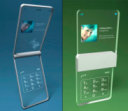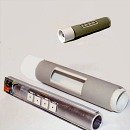New Electronic Inventions
Electronic Pills - Collecting Data Inside The Body

After years of investment and development, wireless devices contained in swallowable capsules are now reaching the market.
Israel-based Given Imaging and the researchers at the University of Buffalo in New York have developed ingestible capsules that record data from inside your body.
These pills contain sensors or tiny cameras that collect information as they travel through the gastrointestinal tract before being excreted from the body a day or two later.
These new electronic inventions transmit information such as acidity, pressure and temperature levels or images of the esophagus and intestine to your doctor's computer for analysis.
Doctors often use invasive methods such as catheters, endoscopic instruments or radioisotopes for collecting information about the digestive tract. So device companies have been developing easier, less intrusive ways, to gather information.
Digestive diseases and disorders can include symptoms such as acid reflux, bloating, heartburn, abdominal pain, constipation, difficulty swallowing or loss of appetite.
 "One of the main challenges is determining just what is happening in the stomach and intestines." says Dr. Anish A. Sheth, Director of the Gastrointestinal Motility Program at Yale-New Haven Hospital.
"One of the main challenges is determining just what is happening in the stomach and intestines." says Dr. Anish A. Sheth, Director of the Gastrointestinal Motility Program at Yale-New Haven Hospital.
Doctors can inspect the colon and peer into the stomach using endoscopic instruments. But some areas cannot be easily viewed, and finding out how muscles are working can be difficult.
Electronic pills are being used to measure muscle contraction, ease of passage and other factors to reveal information unavailable in the past.
Sources: givenimaging.com; buffalo.edu
Transparent Smartphones

Inventors, Jung Won Seo, Jae-Woo Park, Keong Su Lim, Ji-Hwan Yang and Sang Jung Kang, who are scientists at the Korean Advanced Institute of Science and Technology, have created the world's first transparent computer chip.
The chip, known as (TRRAM) or transparent resistive random access memory, is similar to existing chips known as (CMOS) or metal-oxide semiconductor memory, which we use in new electronics.
The difference is that TRRAM is completely clear and transparent. What is the benefit of having transparency?
"It is a new milestone of transparent electronic systems," says Jung Won Seo. "By integrating TRRAM with other transparent electronic components, we can create a total see-through embedded electronic systems."
The technology could enable the windows or mirrors in your home to be used as computer monitors and television screens.
This technology is expected to be available within 3 to 4 years.
Source: www.kaist.edu Photo: www.yankodesign.com
Hollow Flashlight Ann Makosinski is a 16-year-old
student
who competed against thousands of
other young inventors from around the
world to win first prize
and a $25,000
scholarship at Google's International
Science Fair. She invented a battery-free
flashlight. A free energy device that is
powered by
the heat in your hand. While visiting the Philippines, Ann
found that many students couldn't
study at home because they didn't have
electricity for lighting. Unfortunately, this is a
common problem for developing
regions where people don't have
access to
power grids or can't afford the
cost of electricity. Ann recalled reading
how the human body had
enough energy to power a 100-watt
light bulb. This inspired her
to think of how she could
convert body heat directly into electricity to
power a
flashlight. She knew that heated conductive
material causes electrons to
spread outwards and that
cold conductive material causes
electrons to condense inwards. So, if a ceramic
tile is heated, and it's pressed against
a ceramic tile that is cool, then electrons
will move from the hot tile towards the
cool tile producing a current. This
phenomena is known as the
thermoelectric effect. Ann started using ceramic tiles placed on top of each other
with a conductive circuit
between them (known as Peltier tiles) to create the amount of
electricity she needed for her flashlight. Her idea was to
design her flashlight so that when it
was gripped in your hand, your palm
would come in contact with the topside
of the tiles and start heating them. To ensure the underside of the tiles
would be cooler, she had the tiles
mounted into a cut-out area of
a hollow aluminum
tube. This meant that air in the tube
would keep the underside of her tiles
cooler than the heated topside of the
tiles. This would then generate a
current from the hot side to the cold
side so that light
emitting diodes (LEDS) connected
to the tiles would light-up. Ann successfully
created the first flashlight that didn't use
batteries, toxic chemicals,
kinetic or solar energy,
and that always works when you picked it
up. She credits her family for encouraging her
interest in electronics and derives her inspiration
from reading about inventors such as
Nikola Tesla and Marie Curie. She told judges
at the Google competition that her
first toy was a box of transistors. Time Magazine listed Ann as one of
the 30 people
under 30 who are changing the world. She is working on bringing her flashlight to market and is also
developing a headlamp based on the same
technology. Sources: googlesciencefair.com; tedxtalks.ted.com You may like - "The dilemma facing 2 billion people without electricity."
Smartbox Technology Insurance companies are implementing smartbox technology so good drivers can benefit from cheap insurance rates. The smartbox, similar to a black box for airplanes, records details about how your car is driven, which can result in cheap car insurance for responsible drivers. The device is connected to the electronics in your car and collects a wide criteria of information such as time, speed, braking, cornering, acceleration and location. Drivers are high-risk when they drive irresponsibly such as speeding, frequent lane changing, driving in high-risk locations or at high-risk times such as in heavy traffic or late at night. These new electronic inventions are intended to replace the standard practice of categorizing drivers into group behavior to determine insurance coverage and premium payments. For example, young drivers are more likely to drive fast, drive at night. and use a cell phone while driving. Statistically, young drivers are more likely to cause an accident so insurance companies charge them higher rates to cover the costs of accident claims.
So even if you're a young, responsible driver, you will pay high insurance rates because of group behavior. This technology allows you to provide proof that your driving behavior doesn't fit the pattern of your demographic group. All the information collected about your driving can be viewed online - including what you're doing well and what could be improved. Your insurance premium is then calculated according to your driving profile.
Sources: exigeninsurance.com; co-operativeinsurance.co.uk; Photo: mikecco
You may like reading - "SMARTBOX INSURANCE".
Digital Pen A digital pen is one of the new electronic inventions that can help us record information. Despite the digital age, we still use pens. But it would be great to have our handwritten notes and drawings digitally recorded without having to use a scanner. It uploads the information to your computer where it can be viewed, edited and filed as a word processing document. The digital pen utilizes character recognition software and works by recording movement. Features include profile creation, a dictionary and fifteen language options. Source: danedigital.com
Instant Prints
Creating instant prints from a digital camera is one of the new electronic inventions in printing. The Polaroid PoGo™ is a small portable printer that weighs only a few ounces. This new electronic invention connects to a digital camera using a USB cable, or to a mobile phone through wireless Bluetooth. It uses rechargeable batteries or an AC adapter.
Source: zink.com


 But although the tiles generated the necessary wattage
(5.7 milliwatts), Ann discovered that the voltage wasn't
enough. So she added a transformer to boost the
voltage
to 5V, which was more than enough to
make her flashlight work.
But although the tiles generated the necessary wattage
(5.7 milliwatts), Ann discovered that the voltage wasn't
enough. So she added a transformer to boost the
voltage
to 5V, which was more than enough to
make her flashlight work.  The smartbox data is wireless transferred in real time to the insurance company and provides a profile of when, where and how you drive. This profile is then used to compare insurance rates and to reward low-risk driving behavior with cheap insurance rates.
The smartbox data is wireless transferred in real time to the insurance company and provides a profile of when, where and how you drive. This profile is then used to compare insurance rates and to reward low-risk driving behavior with cheap insurance rates. The Zpen from Dane-Elec is a wireless pen that uses a clip-on receiver to digitally record what you write.
The Zpen from Dane-Elec is a wireless pen that uses a clip-on receiver to digitally record what you write.  The printer produces full color 2" x 3" prints using an "inkless" technology. The images are created from heat activated crystals in the photo paper. The photos are water proof, tear proof and smear proof.
The printer produces full color 2" x 3" prints using an "inkless" technology. The images are created from heat activated crystals in the photo paper. The photos are water proof, tear proof and smear proof.




